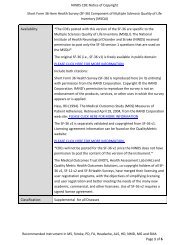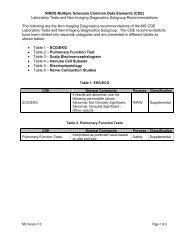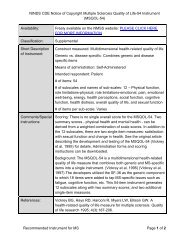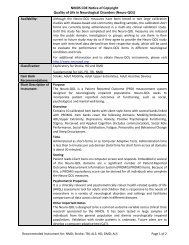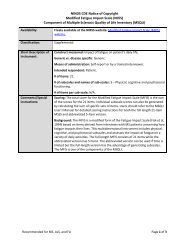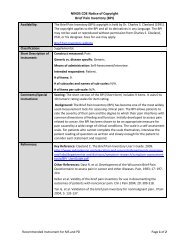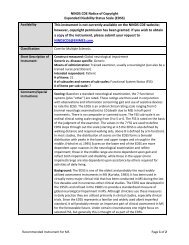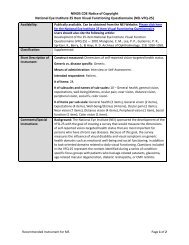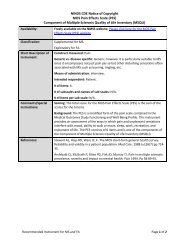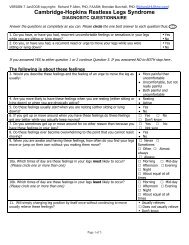NINDS CDE Huntington's Disease Behavioral Psychology Subgroup ...
NINDS CDE Huntington's Disease Behavioral Psychology Subgroup ...
NINDS CDE Huntington's Disease Behavioral Psychology Subgroup ...
Create successful ePaper yourself
Turn your PDF publications into a flip-book with our unique Google optimized e-Paper software.
Description of Problem Behaviours Assessment for HD- short version forHD Common Data ElementsScoringMeasurementsPsychometricPropertiesScoring: Each symptom is rated for severity on a 5 -point scale according todetailed scoring criteria which roughly correspond to the following: 0 = "not at all";1 = trivial; 2 = mild; 3 = moderate (disrupting everyday activities) and 4 = severeor intolerable. Each symptom is also scored for frequency on a 5-point scale asfollows: 0 = symptom absent; 1 = less than once weekly; 2 = at least once aweek; 3 = most days (up to and including some part of every day); and 4 = all day,every day. S everity and f requency scores are multiplied to produce an ov erall‘PBA score’ for each symptom. A lthough it would be pos sible to sum theindividual PBA symptom scores to derive an overall total score, it is unlikely thatthis is very meaningful.Standardization of scores to a reference population (z scores, T scores, etc):Not applicableType of scale used to describe individual items and total/subscale scores(nominal, ordinal, or [essentially] continuous): OrdinalIf ordinal or continuous, explain if ceiling or floor effects are to be expectedif the measure is used in specific HD <strong>Subgroup</strong>s: Significant ceiling effectswere observed in the TRACK-HD study (Tabrizi et al.); for most PBA symptoms,between 25% - 50% of pre-symptomatic HD mutation carriers scored zero forseverity on the more common PBA symptoms (e.g. low mood, anxiety orirritability) with a much higher proportion scoring zero for less common items suchas aggression, suicidal ideation or hallucinations.Reliability:Test-retest or intra-interview (within rater) reliability (as applicable): N/AInter-interview (between-rater) reliability (as applicable): inter-rater reliability wasmeasured in the TRACK-HD study by video-recording interviews and re-scoring ofa random sample by an expert rater. O verall unweighted kappa scores for theseverity ratings were 0.70 and for the frequency ratings, 0.77. Kappa scores inthe range 0.61 – 0.80 are usually considered to represent ‘substantial agreement’.Internal consistency: N/AStatistical methods used to assess reliability: Cohen’s kappa.Validity: Difficult to assess because of the lack of an alternative ‘gold standard’measure. T he selection of symptoms for inclusion in the measure, and thedevelopment of the detailed scoring criteria used, were carried out by a group ofexperts from the EHDN Behavioural Phenotype Working Group. T he range ofsymptoms covered by the measure is very similar to the behavioural section ofthe UHDRS, and the PBA-s is probably best thought of as the latest elaboration ofthe UHDRS behavioural interview.Sensitivity to Change/ Ability to Detect Change (over time or in response toan intervention): The longitudinal rate of change in PBA-s apathy scores over 24months’ follow-up was significantly greater in manifest HD subjects than incontrols (Tabrizi et al., manuscript under review). Analysis of the TRACK-HD 36-HD Version 1.0 Page 2 of 3



